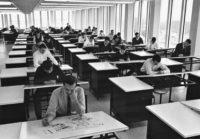On October 9, Richard Meier’s firm announced a spate of promotions and named a new managing principal while declaring that the founder, who was accused of sexual harassment by five women in a bombshell New York Times story this March, would “step back from day-to-day activities,” but remain available to colleagues and clients.
The allegations against Meier marked the start of the architecture community’s public reckoning with gender-based harassment—months after the #MeToo movement rocked Hollywood, the media, and sports—though the largely male profession has long faced strong undercurrents of sexism.
To get a picture of the impact of sexual harassment on the fields of design, engineering and construction, Architectural Record and its sister publication Engineering News-Record (ENR) launched a survey in July. More than 1,200 people responded, with architects and architectural designers (referred to here as “architects,” though not all are licensed) representing about half the participants. Here, we present selected findings, with more information on findings from construction industry available on ENR.com.

Image © Getty Images
Roughly two-thirds of all architects surveyed reported having experienced sexual harassment on a jobsite, at work, or in another location. Women accounted for just over two-thirds of the respondents, with 85 percent saying they have experienced harassment; among the men who replied, 25 percent indicated they have been harassed. Nearly 64 percent of those who alleged harassment characterized it as inappropriate personal requests, questions, jokes or innuendo; for almost 30 percent, it included inappropriate physical contact.
“I was just out of grad school, working in a small firm, where I was the only woman other than the office manager,” said a middle-aged Midwestern architect. “The boss showed up at the office late one night when I was working alone and asked me for a ‘kiss goodnight.’ I declined and said I was uncomfortable with the request. He laughed it off. Then two weeks later I lost my job. My boss said, ‘This has nothing to do with the other day,’ but, given the workload and the praise I had received, it didn’t ring true.”
People responded to harassment in various ways: 12 percent reported it to human resources and almost 19 percent reported it to a manager; nearly 34 percent only shared the experience informally with a colleague. Fewer than half a percent of people who were harassed either filed a lawsuit or a claim with the U.S. Equal Employment Opportunity Commission; 26 percent neither took action nor spoke publicly about the incident.
A woman in the Southwest remembers “being propositioned for dates and sex from clients, a boss, and coworkers during work hours,” as well as hearing offensive comments about women and sex, including the firm’s principal using vulgar sexual terms “followed by laughs from the guys.” But despite her discomfort, she kept quiet. “As a new intern just out of college in an architecture firm with very few female coworkers, there was no way I could speak up and hope to gain the professional experience I needed.”
Some victims reported incidents of harassment to their employers, and just under a third indicated that management responded to their concerns.
Of those who confronted their alleged harassers (just 135 of 599 total respondents), about 46 percent said the accused denied the allegations and became defensive.
For instance, an architect in the Southeast, with four decades of professional experience, said her male colleagues told her to “lighten up, enjoy the attention” after she confronted them about their inappropriate comments to her. “Not much has changed in 40 years,” she said, “except that more women are exposed to it, and there is a dismissive ‘anti-PC’ sentiment, spoken with derision, like, ‘Don’t get all PC about it.’ ”
Our survey also asked whether architects had witnessed incidents of sexual harassment; about 56 percent of those who responded reported witnessing sexual harassment, and 74 percent said they had heard secondhand or been told about an incident.
One example is an older man who runs a small practice in the Southwest with his wife, who reported that “she has been repeatedly subject to gender-different responses from contractors and has stopped doing construction-side work,” where both “subtle and blatant” sexism continues to occur. “We do not condone it and coldly turn away when inappropriate comments or jokes are made,” he said.
The human-resources manager of a small firm in the south-central U.S. contends with such “jokes” and patronizing remarks on a daily basis. “I hear a lot of ‘pet names’—sweetheart, sweetie, or simply ‘woman.’ Here at this small office,” she said, “the only thing that has helped us women is other men coming to our defense and calling out harassment when it happens around them. If we point out obvious harassment ourselves, we are told to laugh it off. If I say it’s not a joke to me, then I’m being too serious.”
A mid-career architecture educator in Canada described the “man-to-man sexual harassment” that he witnessed at the beginning of his career on a jobsite in the New York area, where a supervisor displayed pornography in a construction trailer “as a way to trivialize and mock design drawings—‘You want to show me pictures, I’ll show you pictures.’ ” He calls that episode an instance of “the macho animosity that some in the construction trades harbor toward architects.”
Overall, about two-thirds of those who responded to the survey felt the profession is moving too slowly in addressing sexual harassment. “The AIA has only recently enacted a policy,” said a middle-aged West Coast man, referring to recent changes to the Code of Ethics and Professional Conduct. He believes he was fired from a senior position by his firm’s principals for his sexual orientation.
But the broader cultural awakening does leave some feeling hopeful, including a woman at a New England firm who has faced comments about her appearance, work, and cultural background. “Above all, I am grateful to the people who have spoken up.” The #MeToo movement, she says, has “dramatically improved the quality of my psyche, confidence, and self-worth, because of this new societal awareness and alertness.”




Post a comment to this article
Report Abusive Comment